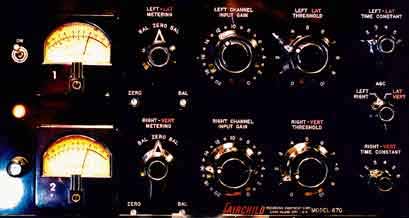Compression Obsession: The Fairchild 670
 |
|
The Fairchild 670
|
“The 670 can get fetch $30,000 and beyond on the vintage market. With its 14 transformers, 20 vacuum tubes, and 6 rack-space encompassing girth, the Fairchild 670 is the heavyweight champion of compression, weighing in at 65 lbs.”
In the annals of compressor history, the products produced by Fairchild are some of the best built, most highly prized, and fetch the greatest dollar amounts on the vintage market. The most famous Fairchild products produced were the 660 and 670 compressor/limiters.
While the mono 660 is almost as desired, the stereo Fairchild 670 is probably the “Holy Grail” of compressors in studio gear esoterica, not only because of its price but its extreme rareness and the difficulties in maintaining such a piece. The 670 can get fetch $30,000 and beyond on the vintage market. With its 14 transformers, 20 vacuum tubes, and 6 rack-space encompassing girth, the Fairchild 670 is the heavyweight champion of compression, weighing in at 65 lbs.
Originating from the early 1950’s, the design of the 670 uses a single push-pull stage of amplification with an extremely high control voltage. The Fairchild 670 is a variable-mu tube limiter. Variable-mu limiters are unique in that they use tubes for gain reduction, and not just as amplifiers. The audio path is quite simple, and compression happens directly in the audio path, rather than sending out to a separate compression circuit.
Controls and Usage
The front panel of the 670 sports a shiny black anodized finish, and features two beautifully large VU meters showing gain reduction. To the left of the meters are the power switch and power light as well as a fuse access. To the far right and center, the unique Left/Right Lat/Vert select switch is found. In Left/Right mode, the 670 incorporates two independent limiters that act on the left and right channels and was specifically designed for stereo level control problems. In Lat/Vert mode, the 670 acts on the lateral and vertical (sum and difference) components of the two stereo channels. This is accomplished by first bringing the two stereo channels through a matrixing network which divides them into their respective lateral and vertical components, limiting these lateral and vertical components and then combining them through a second matrixing network into left and right channels again, much like M/S matrixing. This allows for maximum useable level and efficient use of available groove space in phonograph mastering, resulting in high volume recordings with longer playing times--however, I doubt the 670 is used much in modern mastering, let alone used for this feature.
The remainder of the controls are all paired, including the left and right meter select switches which has Gain Reduction view and also allows views to adjust vacuum tube current matching, in conjunction with set screws found on the front panel. With the three-position switch, one can check all is well by making sure the meter reads zero in all three positions.
Compression and level adjustments are controlled with the stepped Input Gain rotary switch and the continuously variable Threshold control.
A stepped 6-position rotary switch adjusts Attack and Release times.
Four different Attack and Release combinations are available going from fast to slow up the dial--while positions 5 and 6 give auto program-dependent release times, similar to an LA-2A. In addition to these front panel controls, two infinite variable set-screws are found on the rear of the unit, which allow for somewhat haphazard ratio adjustment--one for each channel; some units are customized and users bring those controls to the front.
The unit can be used as a limiter or compressor, depending upon personal taste and program material. It can go from a 2:1 ratio as a compressor to a peak limiter with a 30:1 ratio. The unit can also be adjusted to operate anywhere between these two extremes with the ratio set screws.
History/Origins
The compressor’s origins begin with Sherman Fairchild, the son of Congressman George Winthrop Fairchild, one of the founders of IBM.
Apparently, the young Sherman Fairchild was always in and out of school; but eventually took to design. He built and designed the first aerial photography equipment during WW I. After the war ended, he started the Fairchild Aerial Camera Corporation in 1920.
Soon aerial surveying caught on, and Fairchild started a second company; Fairchild Aerial Surveys. Sherman Fairchild eventually went on to design a multitude of products, from aircraft to semiconductors, and opened several more companies, including Fairchild Recording Equipment Corporation.
--Will Shanks
Questions or comments on this article?